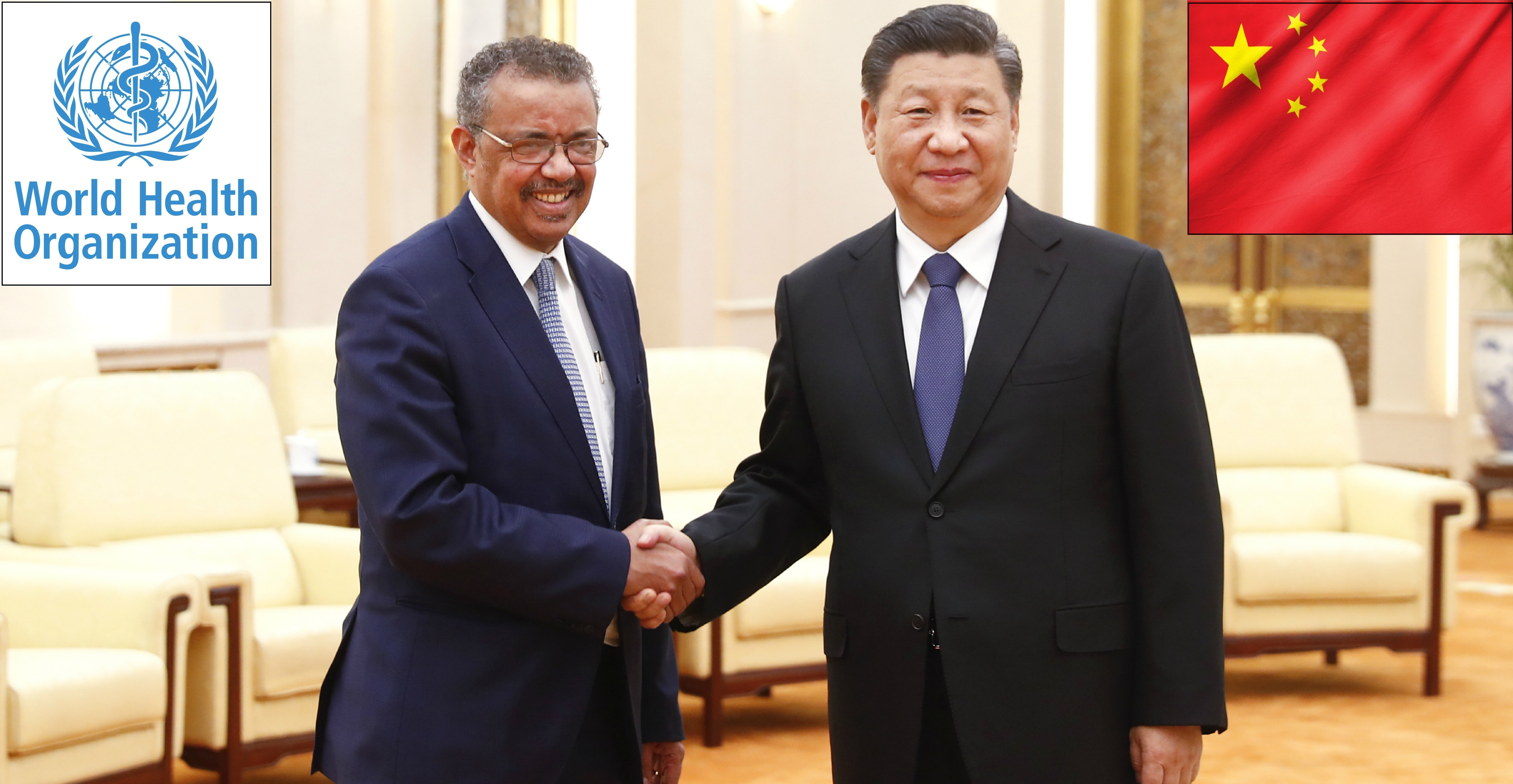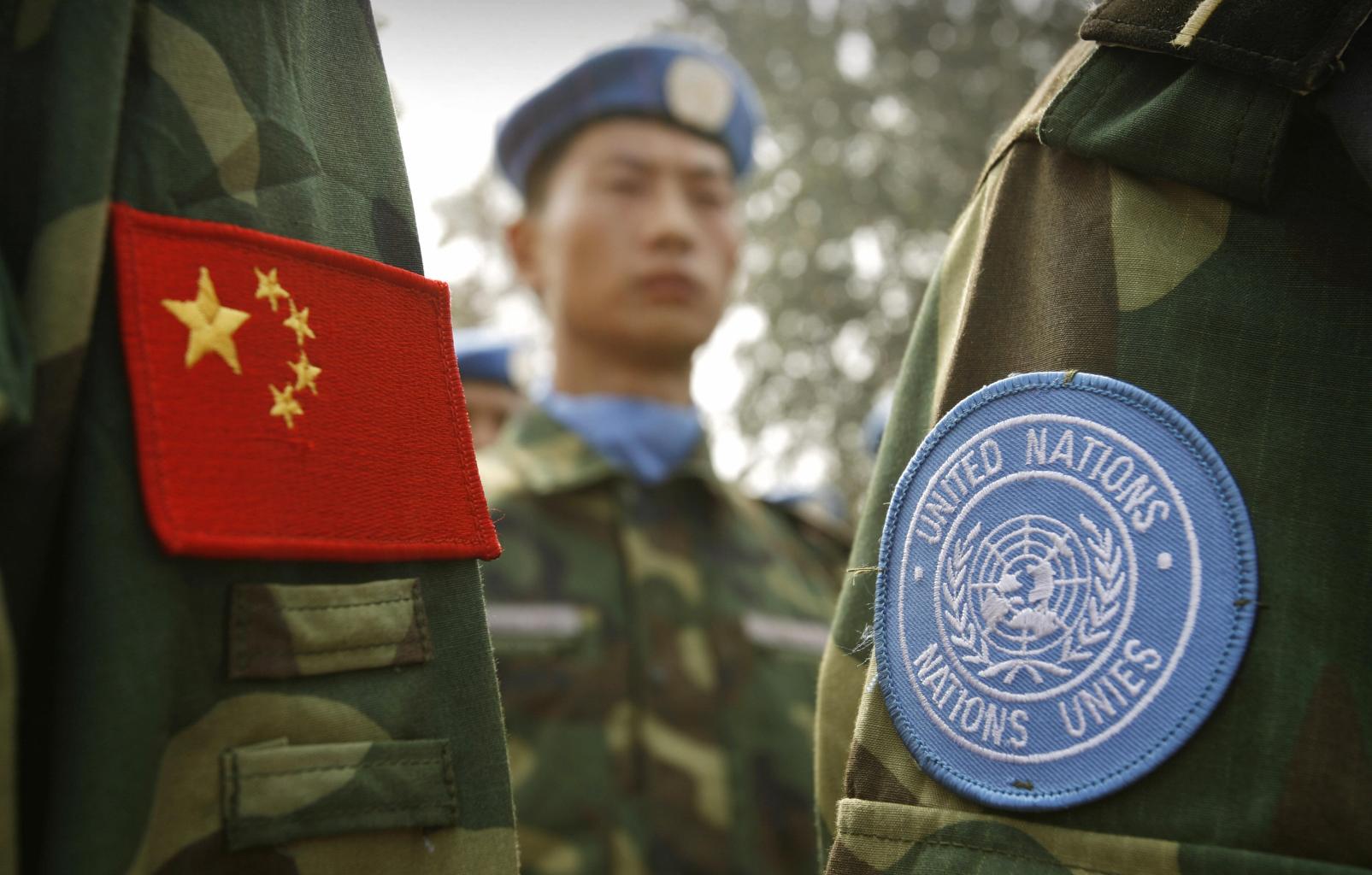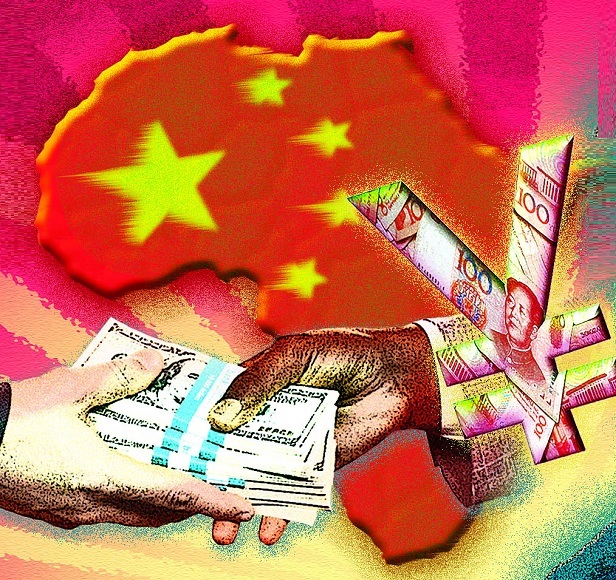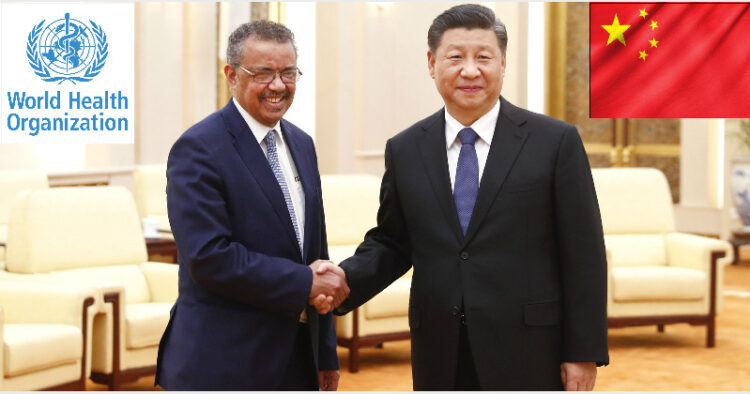The global coronavirus epidemic has exposed the dishonesty not only of the Chinese Communist Party but also of the World Health Organization. It is time India deals both with the People’s Republic of China and with the United Nations through complementary strategy.
– Rahul Goswami

The nexus between China and organisations like the WHO is all too apparant after the outbreak of the Wuhan virus pandemic
The events of recent weeks have laid bare the perfidy of the World Health Organization, the inter-governmental agency of the United Nations whose task it is to coordinate and support technically UN member states’ responses to public health. The WHO, which has been under fire for well over a decade for sins of commission and omission both, including its disastrous mishandling in 2014 of the Ebola outbreak in several countries of Africa, is now facing an inquisition about its dereliction of duties concerning the coronavirus pandemic before which all its previous crises – Ebola, misgovernance, budgetary profligacy – pale.
To blame for the predicament the WHO finds itself in are its top executives of course, but more pertinently, a global pharmaceutical mob whose rapine drove the agency into the grasp of the country that wants, more than any other in the world, to control international agendas, and that country is the People’s Republic of China.
The China that the world has seen and imagined, for a generation now, is in some ways not all that removed from what it was in the 1950s, under the new Communist government, nor from what it was in the 1920s, under the Nationalist government. When in 1929 the Nationalist government proposed to abolish traditional medicine in China, a countrywide strike was called which shut clinics and pharmacies. The result was the creation of two systems, one for traditional medicine practitioners, the other for Western medicine doctors.
In the 1950s, with the country having been ravaged by war, doctors were in desperately short supply. The Communists pragmatically surveyed what remained of the traditional medicine institutions and regulations, found they were mostly intact, and managed with them. It was the Communists who formally coined the term that has been used since then, Traditional Chinese Medicine, even though Chairman Mao considered its practitioners to be no more than “circus entertainers or street hawkers”.
When the Cultural Revolution was whipped up from the mid-1960s into the conflagration that mindlessly consumed the country’s literature, music and arts, and banished China’s cultural practitioners to asylums, or had them executed by firing squads, the traditional medicine institutions lived to cure another day by shutting down. For ten years they stayed shut, and when they reopened at last, they did so as Chinese ‘people’s science’ centres with all the ‘tradition’ hammered out of them.
Beginning of a nexus
It was when Jiang Zemin was president of China and Li Peng (of Tiananmen Square infamy) the premier that a woman named Margaret Chan was appointed Director of Health of Hong Kong, then still a British colony. That was in 1994. Nine years later, Dr Chan joined the World Health Organization (WHO) as a director of one of its departments. Two years thereafter, in 2005, she was appointed director of a more weighty department as well as ‘Representative of the Director-General for Pandemic Influenza’ and in September of that year, Assistant Director-General for Communicable Diseases.
The very next year, 2006, Dr Chan was elected to the post of Director-General of WHO. Hu Jintao was president of the People’s Republic at the time (his premier, Wen Jiabao, with Xi Jinping a vice president). It was during Hu’s tenure that the severe acute respiratory syndrome (Sars) crisis of 2003 swept China, which was roundly criticised for initially covering up and responding too slowly. Between then and now, the parallels are unmistakeable. A national epidemic that is also global, the Chinese Communist Party is slow off the mark to respond and to inform the world, an ally at the top in the WHO, the equivalent of show trials to deflect accountability.
But there are signal differences too. Between Sars and Covid, the globalised economy of manufactures and services that has knit and reknit the world has been directed more, year after successive year, by China. As it grew in heft and bulk as the ‘factory of the world’, Communist China studied with care the institutions of the West, meticulously dissected the mechanisms of the multilateral order. Its trading surpluses (and its no-strings-attached lines of credit to the capital-starved members of the formerly Third World) fostered the vision of a China that had subscribed fully to the liberal-democratic ideals of an international order, and which was now supporting it with its formidable treasury and its technical prowess.
For an agency like the WHO, one of the most prominent amongst the many agencies and specialist sections in the byzantine United Nations System, the balancing of its books of accounts has from the outset been subordinated to its role as being one of the UN’s fulcrum points with which to curb (or boost) a particular bloc’s, or a country’s, international political reach.
Just as the UN Food and Agriculture Organization has done with the multinational crop, food, fertiliser and bio-technology corporations, or as the UN Development Programme has done with the burgeoning private technical consultancies of Europe, the WHO is the court at which the multinational pharmaceutical and drugs corporations must swear fealty so as to partake in the banquet that follows when a particular line of public health policy is adopted by a country or region.
When finance trumps health
It is a partnership (as the WHO and the UN prefer to call such relationships) that was thought up by the agency during Dr Chan’s second term. Going by the name of the Framework for Engagement with Non-State Actors, the new mechanism that the WHO blandly calls a ‘multi-stakeholder governance system’ was signed into effect in 2016, a year before the departure of Dr Chan and the arrival of Tedros Adhanom Ghebreyesus. For the loyal agent of the Chinese Communist Party, Dr Chan’s final gambit could well be the feint that obscured – if only till 2020 – the real game afoot.
Like other major agencies of the UN, the WHO’s budget is financed through a mix of what are called ‘assessed’ and ‘voluntary’ contributions. Assessed contributions are mandatory contributions from the member states (countries) according to a formula based on the size of their economies and populations. In the early 1970s, a full three-quarters of the WHO budget came from assessed contributions. By 1989, the balance between the two kinds of contributions was even.
By 2015 (when the WHO budget was US$2.3 billion) assessed contributions had dropped to less than a quarter. What until then had been considered voluntary contributions added up to barely US$120 million. The rest of what was accounted for as voluntary contributions came from other UN agencies, ‘partnerships’ (such as the Global Fund to Fight Aids, Tuberculosis and Malaria and the Global Vaccines Alliance) and foundations (mainly the Bill and Melinda Gates Foundation). Most of these voluntary contributions were tied to specific WHO programmes.
Against such a background, civil society groups around the world raised an alarm against the Framework for Engagement with Non-State Actors, saying that it “legitimises the framing of public health problems and solutions in favour of the interests and agendas of those actors”. All entirely true. However, the actual plot had moved to a different theatre.
That theatre had begun to be constructed well over a decade earlier in first a few, then several more countries in Africa. It took the form of Chinese development and infrastructural aid and had rapidly reached a point in 2012 where the presence of Chinese corporations in Africa and the Chinese Communist Party’s brigades of representatives in the capital cities were called the re-colonisation of Africa.
China captures Africa and UN

For UN and its branch organisations which are funded by China, financial health has been more important than the well-being and health of the citizens of the planet
So firmly set on this campaign were Beijing’s party mandarins that in 2015, the People’s Republic was confident enough to promise US$60 billion in grants and commercial loans to finance economic development projects in Africa, and confident enough to expect that most of it would be agreed to by the leaders of African countries. The confidence was not misplaced. By 2018, China held 15 percent of sub-Saharan Africa’s total debt stock and is the largest owner of public debt in Africa.
Addis Ababa, the capital of Ethiopia, has had Chinese funding poured into it, with the Chinese Communist Party constructing everything from the metro system to highways and skyscrapers, plus the US$200 million headquarters of the African Union. When the Ethiopia-Djibouti railway was built, the Export-Import Bank of China backed the project with US$3.3 billion in loans, and 400 Chinese investment projects valued at more than US$4 billion were counted in 2019 as operating in the country.
That is why Tedros was the ideal puppet for China, because the Ethiopian People’s Revolutionary Democratic Front – a Marxist party – to which he belonged was already a junior partner. It had first sent a senior delegation to Beijing in 1994 for “China’s advice on Ethiopia’s development”.
During the Warring States period (fifth to third centuries before the Common Era) of historical China, several rival states battled each other viciously for territorial advantage and dominance. It was during this period that the general known as Sun Tzu is thought to have directed some battles, following which his pithy doctrines were compiled. One of them, which the ultimately victorious Qin state adopted, has been translated as, “Let your plans be dark and impenetrable as night, and when you move, fall like a thunderbolt.”
The 25 Politburo members of the Chinese Communist Party favour and implement such tactics. And that is how Dr Margaret Chan was the first to be placed in a UN agency. As of today, the successful staging of such tactics has led to four UN agencies now led by Chinese nationals. In August 2019, China’s former vice-minister of Agriculture and Rural Affairs, Qu Dongyu, became Director-General of the UN Food and Agriculture Organization (FAO). Fang Liu is the Secretary General of the International Civil Aviation Organization (ICAO), Houlin Zhao is Secretary-General of the International Telecommunication Union (ITU) and Li Yong is Director-General of the UN Industrial Development Organization (UNIDO). Had there not been a reversal in the voting pattern early in March 2020 for the election of the Director of the World Intellectual Property Organization (WIPO), a fifth Chinese national would have been added to this contemporary list of dominance.
This is a record for any country in what is called the UN System and augurs ill for the future of that system and, more saliently, for what is understood as multilateralism. Nor is that all. China has placed seven of its nationals as Deputy Directors-General of UN agencies, also a record. China’s mandatory contribution to the UN budget is now second only to the United States of America, and it has also put in place a Peace and Development Fund whose allocation is decided jointly by Chinese diplomats and the UN Secretary-General, and no-one else. Besides, six heads of major UN agencies are from Africa, and from countries into which the People’s Republic has, ‘no strings attached’, poured aid, development assistance, infrastructure and of course trading companies.

Most countries of Africa have been caught in the Chinese debt trap and are forced to be part of its hegemonistic projects like the One Belt One Road
What it means for India
For India, the alarm should have been rung out of its socket several years ago, when the imports by the Indian pharmaceutical and bulk drug manufacturers of active pharmaceutical ingredients from China crossed the 25% threshold. It is only when the factories in China switched off, and the flow of these ingredients stopped, that the country learnt about this import dependency which in February 2020 was found to be around 65% – in 1991 it was less than a percent. India’s exports to the Africa region (54 countries) are dominated by pharmaceutical products.
It has become abundantly clear that India’s strategies for the People’s Republic of China, for the economic colonies of China (such as Sri Lanka which seeks to escape the Beijing debt trap, and Cambodia, which is sinking further into it) and for the United Nations, need to complement one another. Especially for our major line ministries that are exposed to UN agency ‘country cooperation strategies’ (as they are called by the UN), every agreement, every clause in those agreements and every interaction with UN staff at any level must now be vetted and re-assessed.
Doing so is particularly important for the Ministry of Health and Family Welfare, the Ayush Ministry, the Ministry of Drinking Water and Sanitation and the Department of Telecommunications (Ministry of Communications). Sun Tzu’s fabled advice has become a staple in business management schools, despite the lack of a reliable historical record for the alleged Chinese general. Our heroes, on the other hand, were firmly flesh-and-blood, and vanquished in their time all comers, never mind Chinese phantoms. So must we.
(Author is an expert on intangible cultural heritage and safeguarding of traditional knowledge systems)














Comments